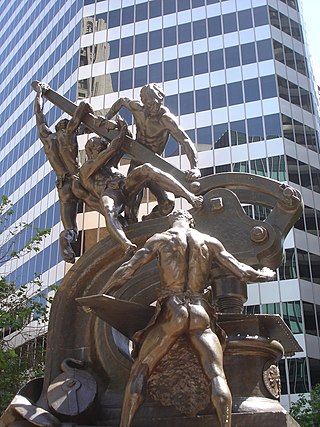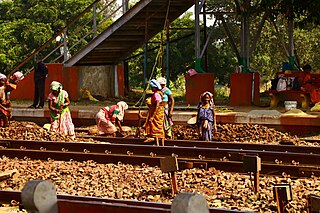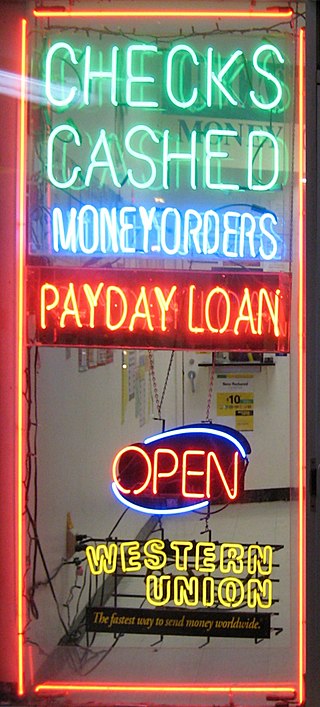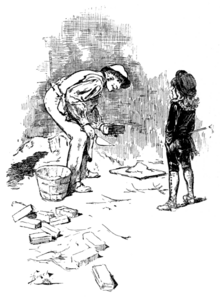
A social class or social stratum is a grouping of people into a set of hierarchical social categories, the most common being the working class, middle class, and upper class. Membership of a social class can for example be dependent on education, wealth, occupation, income, and belonging to a particular subculture or social network.

In sociology and in economics, the term conspicuous consumption describes and explains the consumer practice of buying and using goods of a higher quality, price, or in greater quantity than practical. In 1899, the sociologist Thorstein Veblen coined the term conspicuous consumption to explain the spending of money on and the acquiring of luxury commodities specifically as a public display of economic power—the income and the accumulated wealth—of the buyer. To the conspicuous consumer, the public display of discretionary income is an economic means of either attaining or of maintaining a given social status.

Social class in the United States refers to the idea of grouping Americans by some measure of social status, typically by economic status. However, it could also refer to social status and/or location. The idea that American society can be divided into social classes is disputed, and there are many competing class systems.

In economics, income distribution covers how a country's total GDP is distributed amongst its population. Economic theory and economic policy have long seen income and its distribution as a central concern. Unequal distribution of income causes economic inequality which is a concern in almost all countries around the world.
Nouveau riche, new rich or new money is a social class of the rich whose wealth has been acquired within their own generation, rather than by familial inheritance. These people previously had belonged to a lower social class and economic stratum (rank) within that class and the term implies that the new money, which constitutes their wealth, allowed upward social mobility and provided the means for conspicuous consumption, the buying of goods and services that signal membership in an upper class. As a pejorative term, nouveau riche affects distinctions of type, the given stratum within a social class; hence, among the rich people of a social class, nouveau riche describes the vulgarity and ostentation of the newly rich person who lacks the worldly experience and the system of values of old money, of inherited wealth, such as the patriciate, the nobility, and the gentry.

The working poor are working people whose incomes fall below a given poverty line due to low-income jobs and low familial household income. These are people who spend at least 27 weeks in a year working or looking for employment, but remain under the poverty threshold.
Cosmo Landesman is a British-based American-born journalist and editor. With his then-wife Julie Burchill and friend Toby Young, he founded the magazine Modern Review, which operated from 1991 to 1995 with Young as editor.
In economics, a cycle of poverty or poverty trap is when poverty seems to be inherited causing subsequent generations to not be able to escape it. It is caused by self-reinforcing mechanisms that cause poverty, once it exists, to persist unless there is outside intervention. It can persist across generations, and when applied to developing countries, is also known as a development trap.
Feminization of poverty refers to a trend of increasing inequality in living standards between men and women due to the widening gender gap in poverty. This phenomenon largely links to how women and children are disproportionately represented within the lower socioeconomic status community in comparison to men within the same socioeconomic status. Causes of the feminization of poverty include the structure of family and household, employment, sexual violence, education, climate change, "femonomics" and health. The traditional stereotypes of women remain embedded in many cultures restricting income opportunities and community involvement for many women. Matched with a low foundation income, this can manifest to a cycle of poverty and thus an inter-generational issue.

Poverty in the United Kingdom is the condition experienced by the portion of the population of the United Kingdom that lacks adequate financial resources for a certain standard of living, as defined under the various measures of poverty.
The social structure of the United Kingdom has historically been highly influenced by the concept of social class, which continues to affect British society today. British society, like its European neighbours and most societies in world history, was traditionally divided hierarchically within a system that involved the hereditary transmission of occupation, social status and political influence. Since the advent of industrialisation, this system has been in a constant state of revision, and new factors other than birth are now a greater part of creating identity in Britain.

Poverty is measured in different ways by different bodies, both governmental and nongovernmental. Measurements can be absolute, which references a single standard, or relative, which is dependent on context. Poverty is widely understood to be multidimensional, comprising social, natural and economic factors situated within wider socio-political processes.

In the United States, the lower class are those at or near the lower end of the socioeconomic hierarchy. As with all social classes in the United States, the lower class is loosely defined and its boundaries and definitions subject to debate and ambiguous popular opinions. Sociologists such as W. Lloyd Warner, Dennis Gilbert and James Henslin divide the lower classes into two. The contemporary division used by Gilbert divides the lower class into the working poor and underclass. Service and low-rung manual laborers are commonly identified as being among the working poor. Those who do not participate in the labor force and rely on public assistance as their main source of income are commonly identified as members of the underclass. Overall the term describes those in easily filled employment positions with little prestige or economic compensation who often lack a high school education and are to some extent disenfranchised from mainstream society.

The social structure of China has an expansive history which begins from the feudal society of Imperial China to the contemporary era. There was a Chinese nobility, beginning with the Zhou dynasty. However, after the Song dynasty, the powerful government offices were not hereditary. Instead, they were selected through the imperial examination system, of written examinations based on Confucian thought, thereby undermining the power of the hereditary aristocracy.

Social reproduction describes the reproduction of social structures and systems, mainly on the basis of particular preconditions in demographics, education and inheritance of material property or legal titles. Reproduction is understood as the maintenance and continuation of existing social relations. Originally formulated by Karl Marx in Das Kapital, this concept is a variety of Marx's notion of economic reproduction.
Asset poverty is an economic and social condition that is more persistent and prevalent than income poverty. It is a household’s inability to access wealth resources that are sufficient to provide for basic needs for a period of three months. Basic needs refer to the minimum standards for consumption and acceptable needs. Wealth resources consist of home ownership, other real estate, net value of farm and business assets, stocks, checking and savings accounts, and other savings. Wealth is measured in three forms: net worth, net worth minus home equity, and liquid assets. Net worth consists of all the aspects mentioned above. Net worth minus home equity is the same except it does not include home ownership in asset calculations. Liquid assets are resources that are readily available such as cash, checking and savings accounts, stocks, and other sources of savings. There are two types of assets: tangible and intangible. Tangible assets most closely resemble liquid assets in that they include stocks, bonds, property, natural resources, and hard assets not in the form of real estate. Intangible assets are simply the access to credit, social capital, cultural capital, political capital, and human capital.

In the United States, poverty has both social and political implications. In 2020, there were 37.2 million people in poverty. Some of the many causes include income inequality, inflation, unemployment, debt traps and poor education. The majority of adults living in poverty are employed and have at least a high school education. Although the US is a relatively wealthy country by international standards, it has a persistently high poverty rate compared to other developed countries due in part to a less generous welfare system.

A cost of poverty, also known as a ghetto tax, a poverty premium, a cost of being poor, or the poor pay more, is the phenomenon of people with lower incomes, particularly those living in low-income areas, incurring higher expenses, paying more not only in terms of money, but also in time, health, and opportunity costs. "Costs of poverty" can also refer to the costs to the broader society in which poverty exists.

Socioeconomic mobility in the United States refers to the upward or downward movement of Americans from one social class or economic level to another, through job changes, inheritance, marriage, connections, tax changes, innovation, illegal activities, hard work, lobbying, luck, health changes or other factors.

Social class in Luxembourg after 1945 is generally based on occupation, personal income, and spending power as well as rights to social welfare rather than birth circumstances and family background. The country's demographic situation has changed considerably since 1945, where a mostly blue-collar working population gave way to mostly white-collar occupations over the second half of the twentieth century. Differences in consumer patterns between the white-collar and blue-collar workers decreased considerably between 1963 and 1977, causing a socio-economic evolution that saw a wider sphere of access for both working and middle classes to consumer goods such as cars, white goods, and real estate, thus demonstrating an equalisation of social strata in terms of income and spending power. The population of Luxembourg has also altered in nature due to significant growth in numbers of residents and increases in migration patterns since the mid-twentieth century; in 1961 13% of the population consisted of non-Luxembourgers, by 2020, this is at 44.3. At present, 47% of the Luxembourgish population has a migrant background’, and this is as a result of the response to socioeconomic processes that drew large numbers of immigrants to the country in the latter half of the twentieth century.














